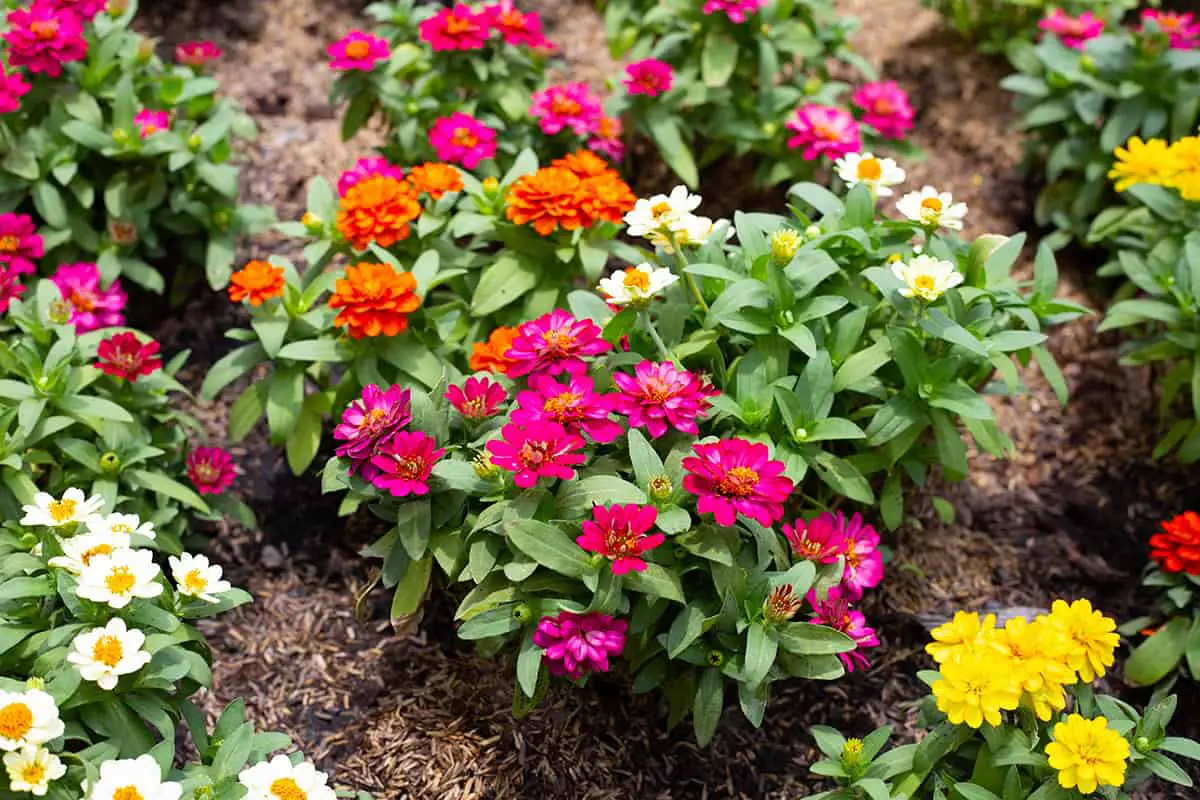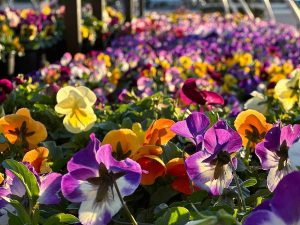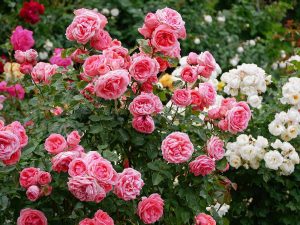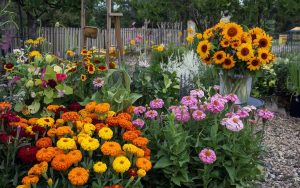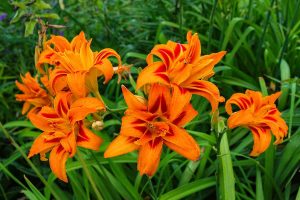Gardening should be a joy, not a chore. Consider the beauty of a garden full of blooms that don’t require constant bending and snipping to keep it looking its best. This is the reality with plants that don’t need deadheading. The hardy and vibrant bee balm, for instance, thrives and reblooms all on its own, giving you more time to enjoy your garden’s beauty without the maintenance.
In this article, we’ll dive into a selection of plants like that don’t need deadheading to guarantee a high-impact, low-maintenance garden.
Table of Contents
- Plants That Don’t Need Deadheading
- Impatiens
- Begonias
- Lobelia
- Alyssum (Sweet Alyssum)
- Vinca (Catharanthus Roseus)
- Geraniums (Pelargonium)
- Coleus
- Salvia
- New Guinea Impatiens
- Million Bells (Calibrachoa)
- Snapdragons (Antirrhinum Majus)
- Petunias
- Fuchsia
- Marigolds (Tagetes)
- Wax Begonia
- Nemesia
- Dianthus
- Osteospermum (African Daisy)
- Angelonia
- Lantana
- Portulaca
- Zinnia
- Cosmos
- Torenia
- Gaura
Plants That Don’t Need Deadheading
Impatiens
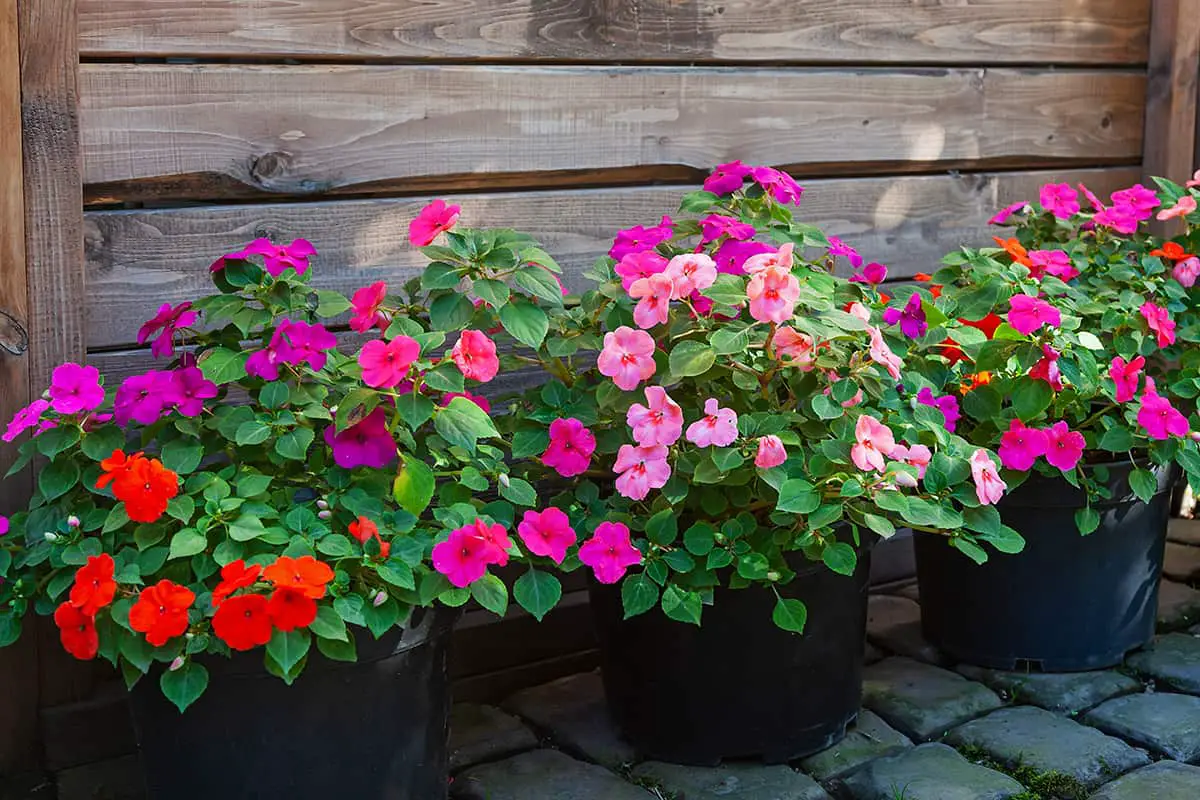
Impatiens offer you colorful blooms without the need for deadheading. These plants thrive in shaded areas and maintain their beauty all season. You’ll find that impatiens come in various colors, such as white, pink, and purple, adding vibrancy to your garden with minimal effort.
If you seek to add more flair to your garden, explore the Fiesta double impatiens. Notably, they do not need deadheading. They can bloom splendidly in hanging baskets, giving you a lush display with minimal upkeep.
Remember, impatiens prefer shade but can tolerate morning sun. In the right conditions, they will flourish beautifully and provide continuous color. Warmth and moisture are your allies in caring for these plants.
Begonias
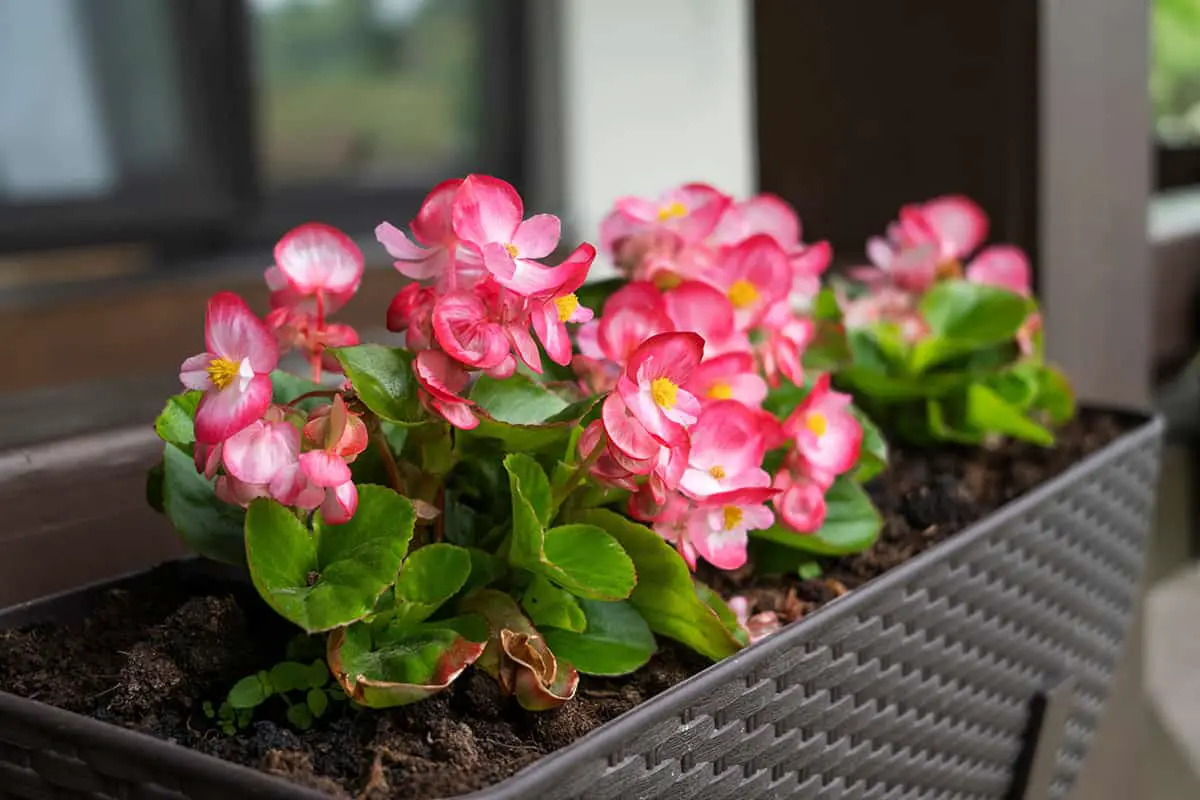
Begonias offer beauty without high maintenance. You can enjoy their vibrant colors without deadheading. These plants possess self-cleaning flowers. Old blooms fall away as new ones emerge throughout summer and fall.
They thrive in various conditions. Place your begonias in shade or full sunlight. They adapt to either setting. Water and light fertilizer sustain their growth. Be cautious not to overdo it; too much causes bud drop.
Several begonia types exist. The American Begonia Society classifies them by species and growth habit. Familiar ones in gardens include tuberous, fibrous-rooted, and rhizomatous begonias. Each kind brings a distinctive leaf shape and flower.
Lobelia

Your garden benefits from the easy care of lobelia. With lobelia, you usually don’t need to remove spent blooms. These plants keep flowering without regular pruning. This feature makes lobelia a practical choice for both beginner and experienced gardeners.
Seasonal care for lobelia is straightforward. Ensure they’re planted in slightly acidic soil for optimal growth. Their preference for well-draining, rich soil allows them to thrive with minimal intervention.
Lobelia flowers add a splash of color throughout the growing season. You’ll find they add visual interest to garden beds, hanging baskets, and window boxes.
Alyssum (Sweet Alyssum)
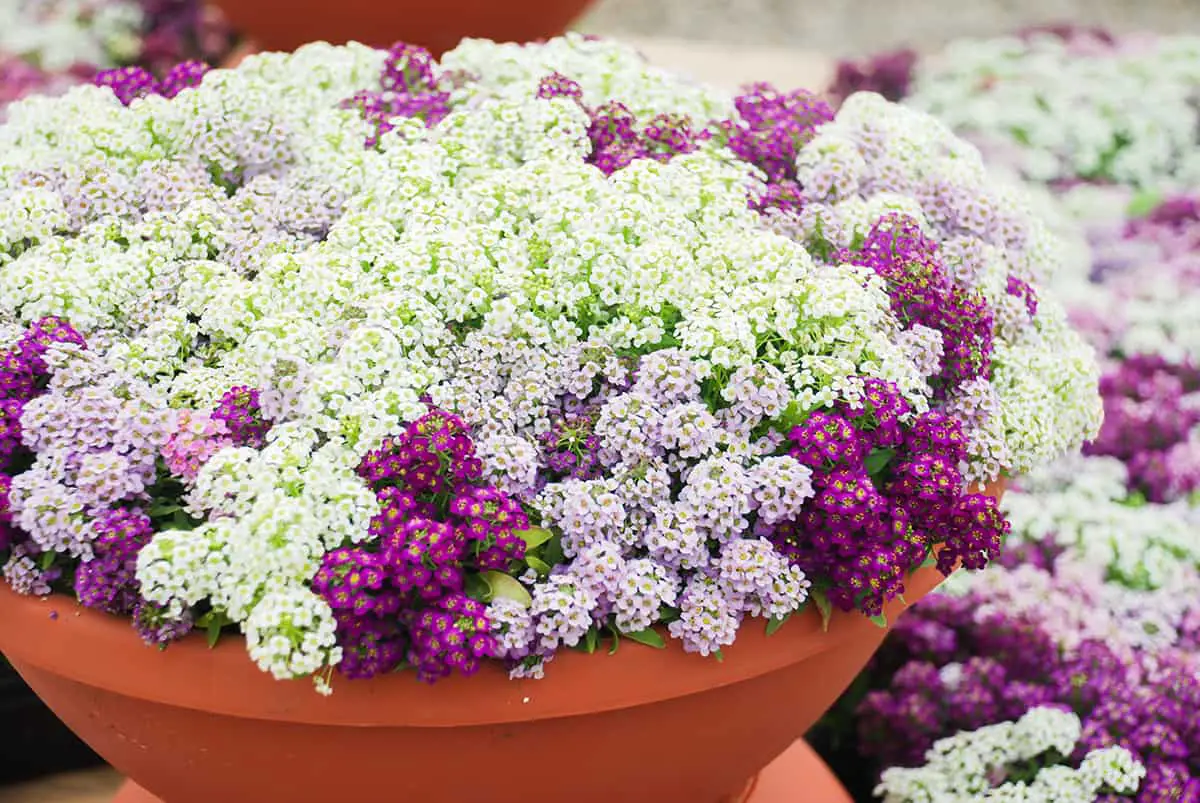
Alyssum, commonly known as Sweet Alyssum, is a low-maintenance plant that does not require deadheading. You’ll appreciate its ability to bloom profusely without the extra work of removing old flowers. This characteristic makes it an ideal choice for gardeners seeking ease and continuous beauty.
Sweet Alyssum’s small, fragrant blossoms cover the plant in clusters, bringing a delicate aesthetic to your garden. You can expect a long flowering season, from spring until frost, in most regions. The plant thrives in well-drained soil and enjoys full sun to partial shade.
By choosing Sweet Alyssum for your garden, you save time while maintaining a lovely floral display. Its self-cleaning nature allows for ongoing blooms without intervention. This makes Sweet Alyssum a perfect addition to hanging baskets and garden beds alike.
Your garden will also benefit from Sweet Alyssum’s tendency to attract beneficial insects, which aid in keeping pests at bay.
Vinca (Catharanthus Roseus)
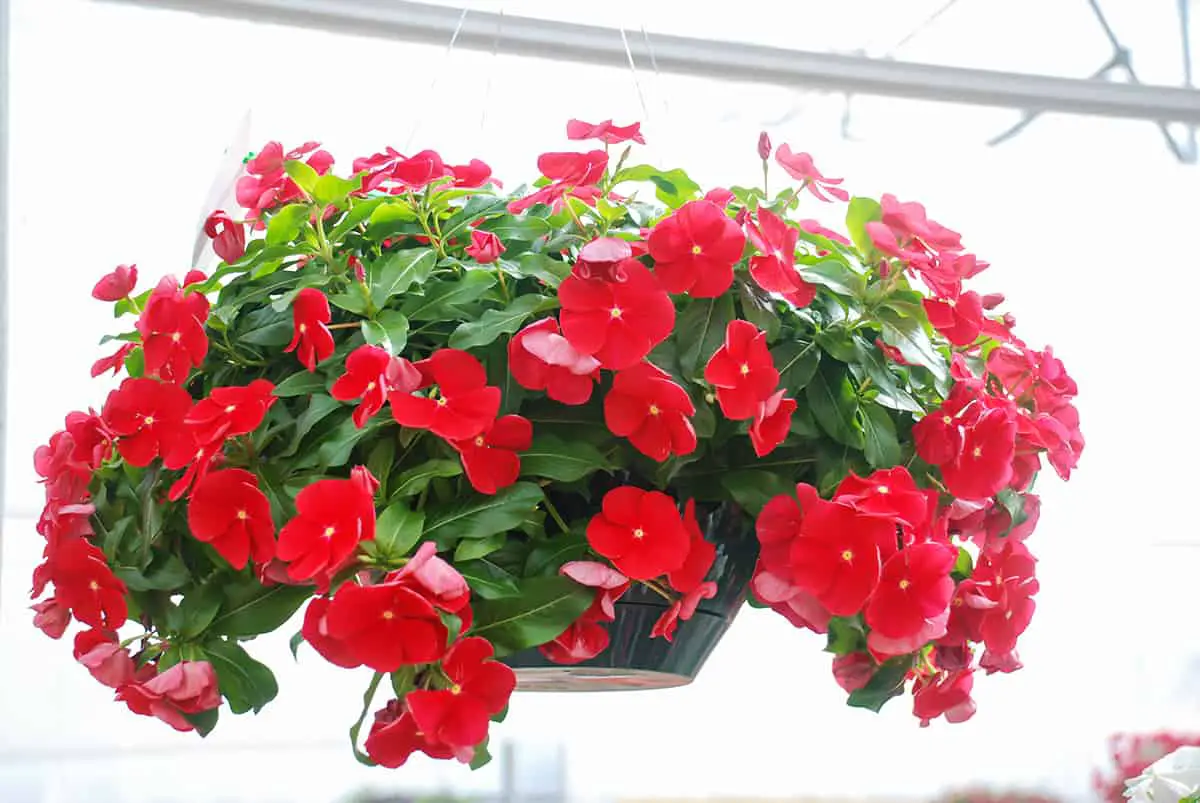
Vinca, known scientifically as Catharanthus roseus, stands out in gardens. You appreciate its low-maintenance charm, especially because it requires no deadheading. The plants are self-cleaning, allowing you to enjoy their beauty with minimal effort.
The North Carolina Extension Gardener Plant Database confirms that Vinca flowers continuously. From July to September, your garden stays vibrant, thanks to its long blooming season. These resilient flowers thrive in full sun and well-drained soils, boasting a range of colors from rose-pink to white.
According to Clemson University’s Home & Garden Information Center, Vinca favors slightly acidic soil with a pH of 5.5 to 6.0. Yet, its adaptability allows for growth even in higher pH soils. Your Vinca will prosper without the need for pinching or deadheading, simplifying your gardening experience.
Geraniums (Pelargonium)
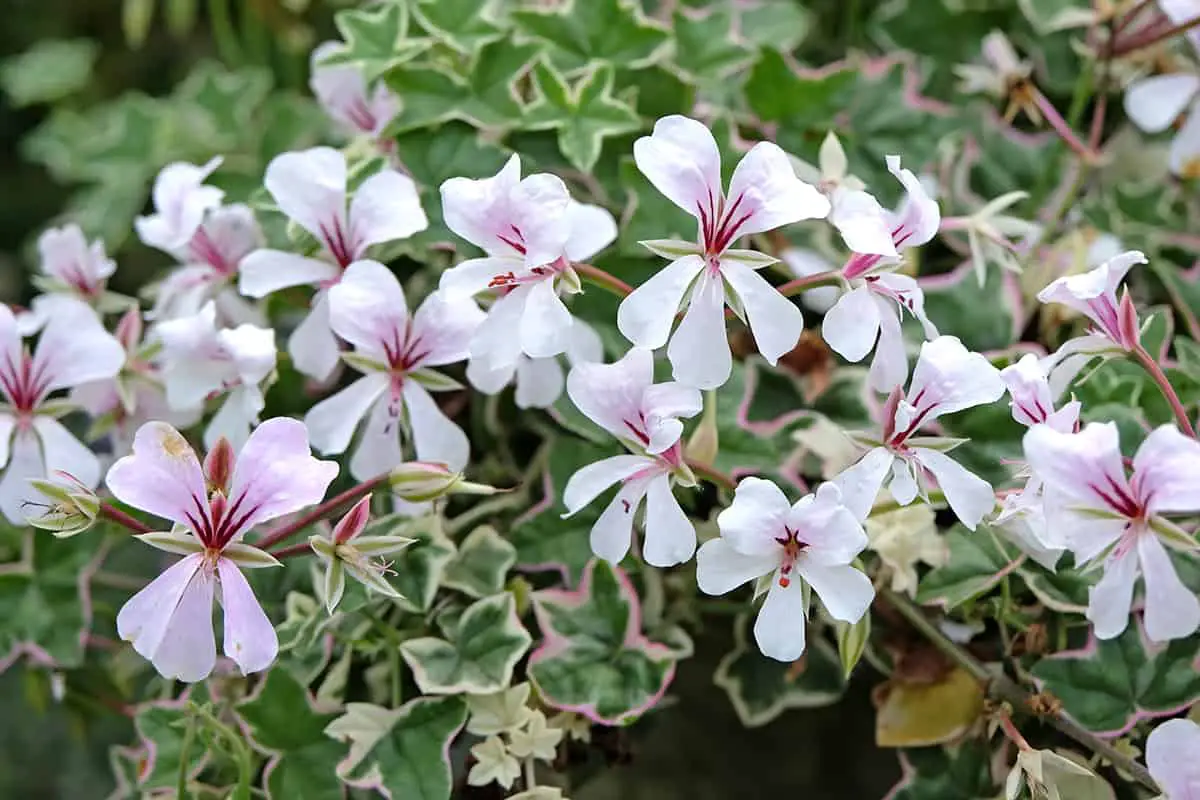
Geraniums, also known as Pelargoniums, offer bright blooms and require minimal maintenance.
Newer varieties of geraniums are bred to be self-cleaning. These flowers drop spent petals on their own. So you can spend less time on upkeep. You get continuous blossoms throughout the season with these types of geraniums.
They need well-drained soil and plenty of sunlight. Indoor geraniums enjoy cool temperatures, between 65° and 70°F during the day and 60° to 65°F at night
Coleus
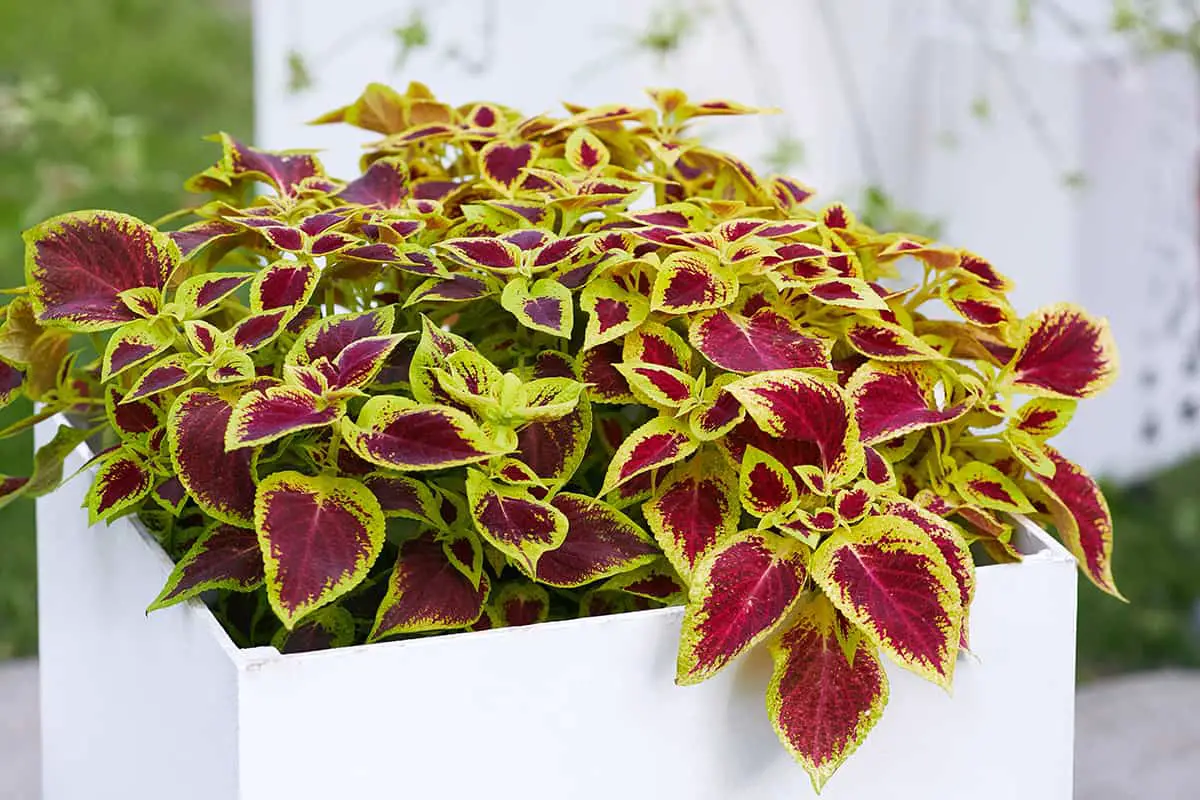
Coleus stands out for its stunning foliage rather than its flowers. Since the focus is on the leaves, there’s no need for deadheading.
Propagation is simple, often done by taking stem cuttings from a healthy plant. You can easily create more plants for your garden. When it flowers, pinching off the blooms can help maintain a bushy appearance and promote leaf growth.
Coleus is well-known for its vibrant leaves and patterns. It performs well in both sun and shade. This versatility means you can plant coleus in different areas of your garden.
Salvia

Salvias are a great choice if you’re seeking plants that maintain a tidy appearance without deadheading. These resilient perennials and annuals bloom profusely throughout the season. They come in many colors, including purples, reds, and yellows. Rockin’ Deep Purple and Fuchsia are vibrant, trouble-free hybrids known for continuous blooms.
The Rockin’ Golden Delicious variety is a standout with its foliage and bloom. Its golden leaves and purplish flowers enhance any garden palette. This variety, like its Rockin counterparts, won’t set seed or become weedy.
For cooler climates, the Scarlet Sage adapts well as a bedding plant. It can grow up to 2 to 4 feet tall and is known for its vase shape and fast growth rate. The branches carry medium green, slightly hairy leaves with scalloped edges.
New Guinea Impatiens
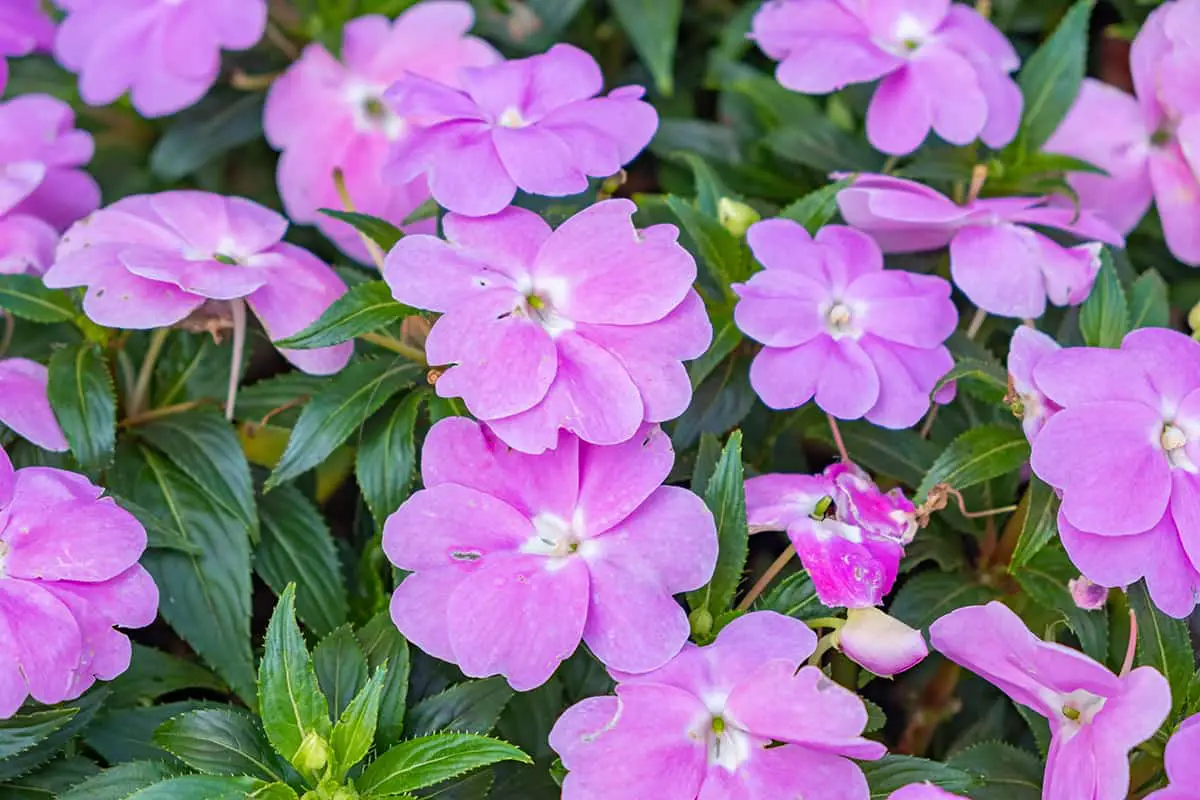
Your garden can shine without the hassle of deadheading, thanks to New Guinea Impatiens.
New Guinea Impatiens thrive in partial to full shade. They suit various garden styles and are especially ideal for shady spots. Ensure the soil stays moist but not soggy. Overwatering can lead to root issues, while underwatering can cause wilt.
With their inherent resistance to many common floral diseases, these plants rarely succumb to the problems that often plague other species. They are robust, with a notable capacity to withstand full sun
Million Bells (Calibrachoa)
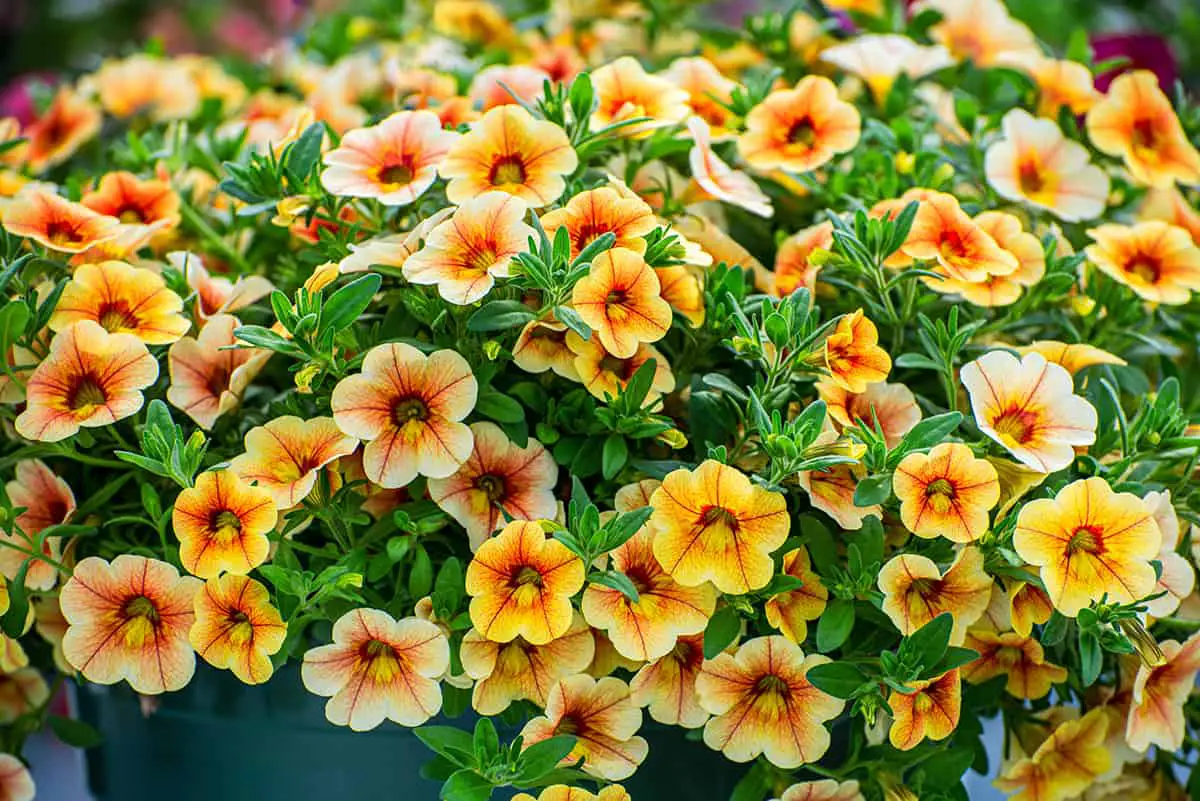
Million Bells is a prolific bloomer that doesn’t necessitate deadheading. Its flowers drop naturally, ensuring non-stop flowering throughout the season.
Calibrachoa bears a strong resemblance to petunias yet stands apart in its care. It thrives in sun and brings a cascade of color. Imagine trailing blossoms from containers or hanging baskets without extra work. With a range of hues, they suit any garden palette.
Place them in well-draining soil and water when dry. They do well in various conditions but prefer not to be too wet. During growth, a light application of fertilizer every other week is enough. That’s all you need to maintain a season-long show.
Snapdragons (Antirrhinum Majus)
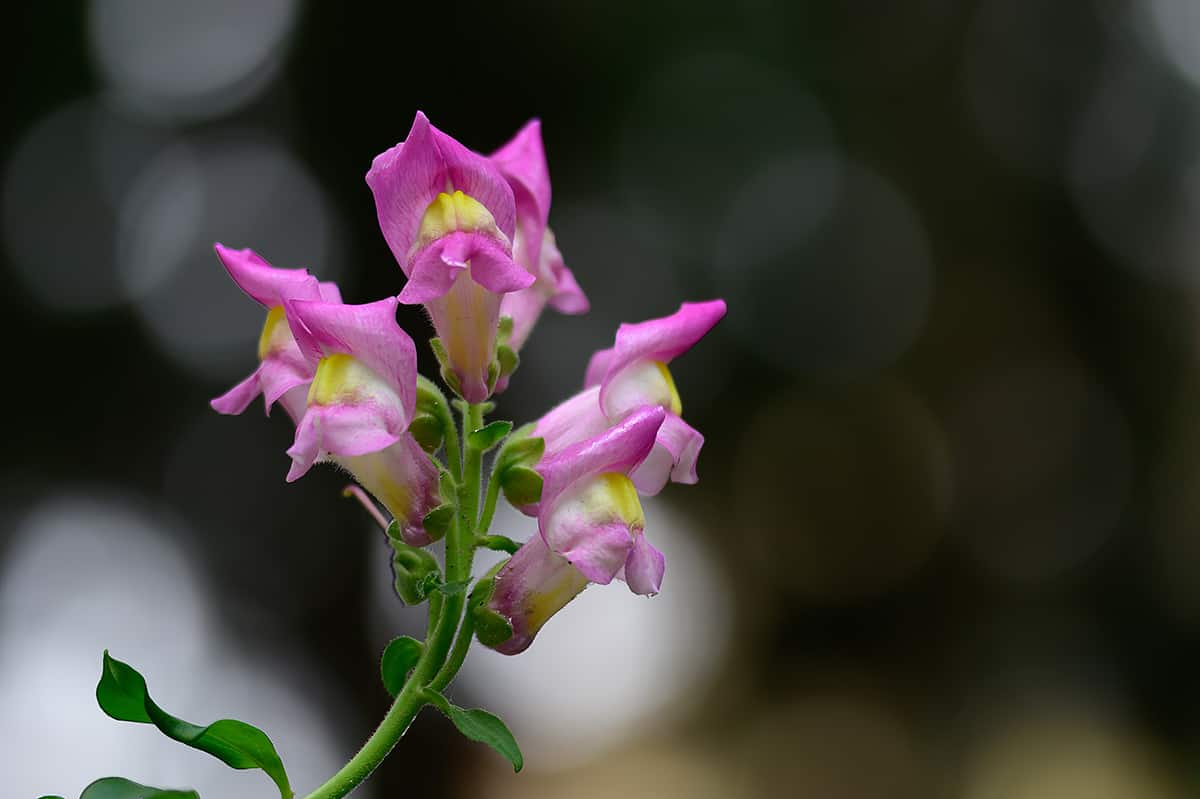
Snapdragons are admired for their unique flower shape and vibrant colors. They brighten gardens without needing deadheading.
These plants handle cool temperatures well. They flourish in the fall and spring. Plant them when it’s cooler for best results. In the South, their blooming aligns with mild winters.
Remember, these flowers are cold hardy. They thrive in low 40s at night and 70s by day.
Petunias
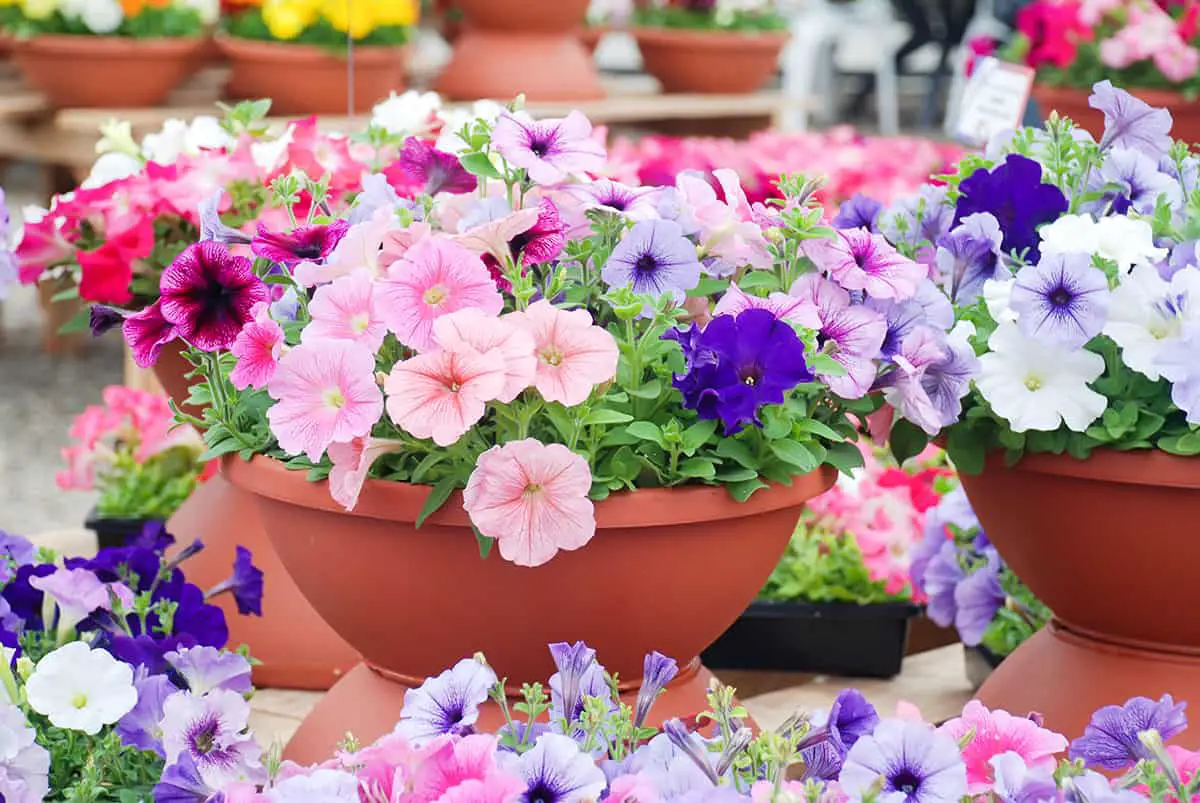
Petunias are beloved for their trumpet-shaped flowers and array of colors. While some varieties might benefit from deadheading, many new cultivars are self-cleaning and don’t need it.
These plants flourish with at least five hours of sunlight daily. Full sun exposure leads to even better performance. In the growing season, water the petunias when the soil’s surface feels dry. Fertilize every two weeks until mid-summer to support their bloom production. If overgrowth occurs, you can rejuvenate them. By mid-summer, cut them back to about half their length.
Petunias can thrive in containers, beds, or as edging in your garden. They adapt and overflow containers beautifully, adding color and life.
Fuchsia
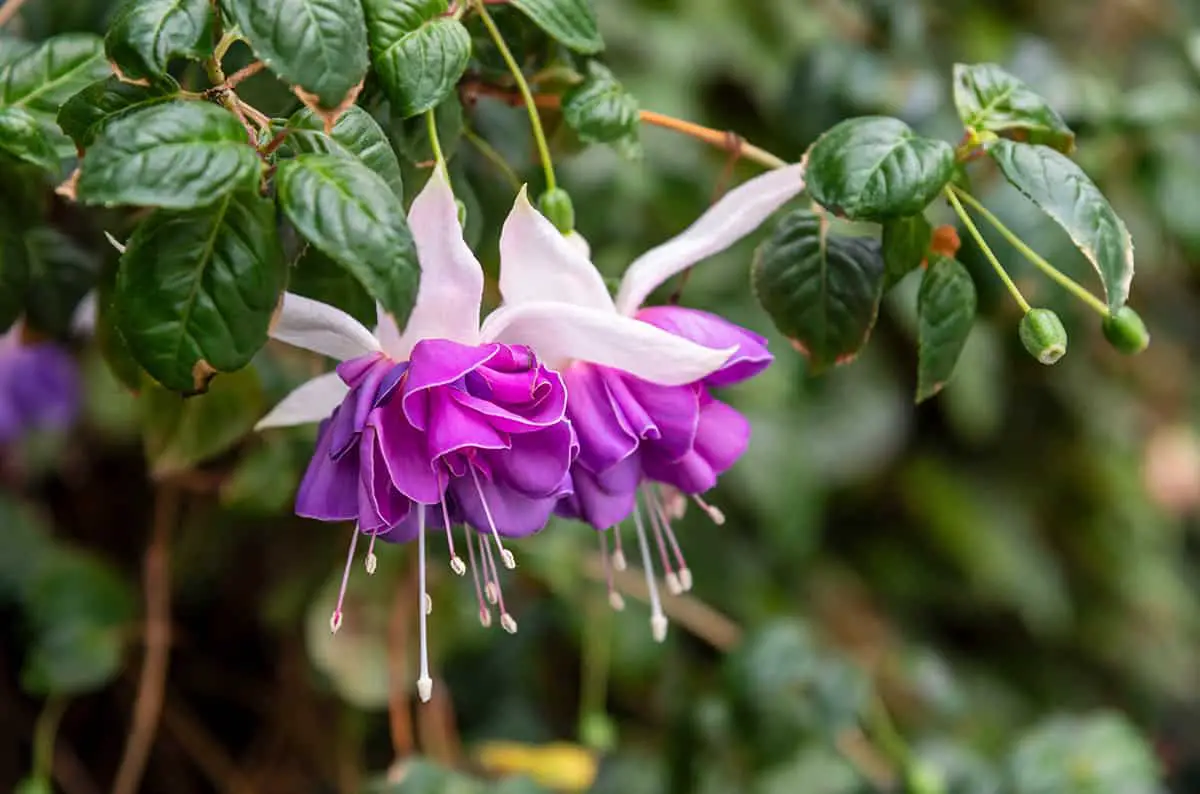
Fuchsia is a captivating plant with pendant-like flowers that naturally drop when spent.
These plants resist setting seeds, meaning they won’t crowd your space with unwanted growth. They also don’t cease flowering. You can expect a spread of color ranging from deep purples to vibrant fuchsias.
The genus Fuchsia includes a range of species, with Fuchsia x hybrida being a popular choice. These hybrid plants result from a cross between species from Mexico and southern regions of South America. They are widely appreciated in mild climates, but in colder regions, they are often grown as potted flowering plant
Marigolds (Tagetes)

Marigolds are a garden favorite for their ease of care and vibrant colors.
They belong in your garden if you seek blooms that require minimal maintenance. African marigolds can grow quite tall, while Signet marigolds stay small, both types showcasing a range of warm colors.
As annuals or perennials, marigolds adapt well to different soil types. They offer an inviting environment for beneficial insects due to their pest deterrent properties. Their broad flowering period spans from early summer to the first frost. Your marigolds stay presentable without regular deadheading, yet occasional trimming can stimulate new blooms.
In terms of varieties, African marigolds stand out with their large double flowers and robust height. If you have more modest space or prefer a petite plant, Signet marigolds might be your match with their charming, mounding habit. Both varieties share the trademark marigold resilience, making them a stress-free choice for gardeners.
Wax Begonia
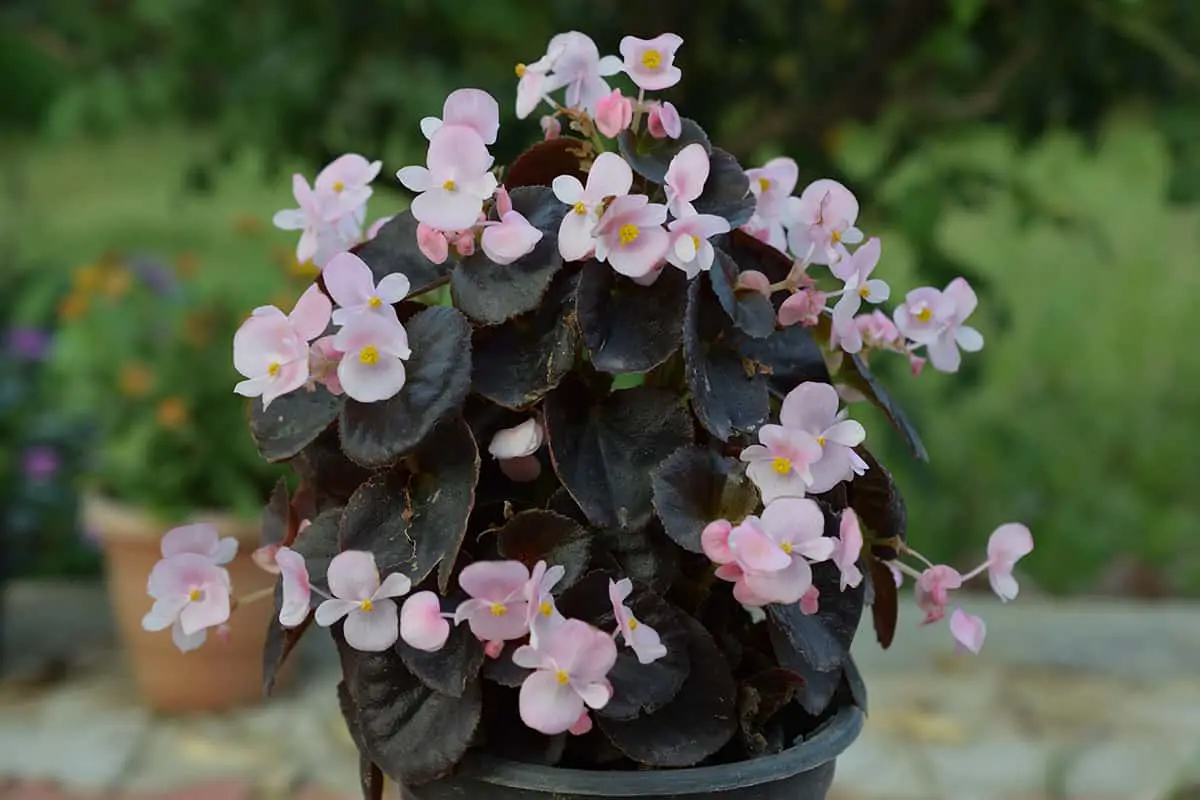
Wax Begonia is a resilient plant that requires minimal upkeep. The self-cleaning nature of Wax Begonia means spent blooms fall off on their own. Your garden stays tidy with less effort from you.
The foliage of the Wax Begonia can range from a rich green to a deep bronze hue. In sunlight, they gain a compact form and even red tones may appear. If you prefer a more tropical appearance, partial shade offers a lusher feel.
Care for your Wax Begonia includes light watering and well-drained soil. They are suitable for outdoor gardens and also thrive indoors.
Nemesia
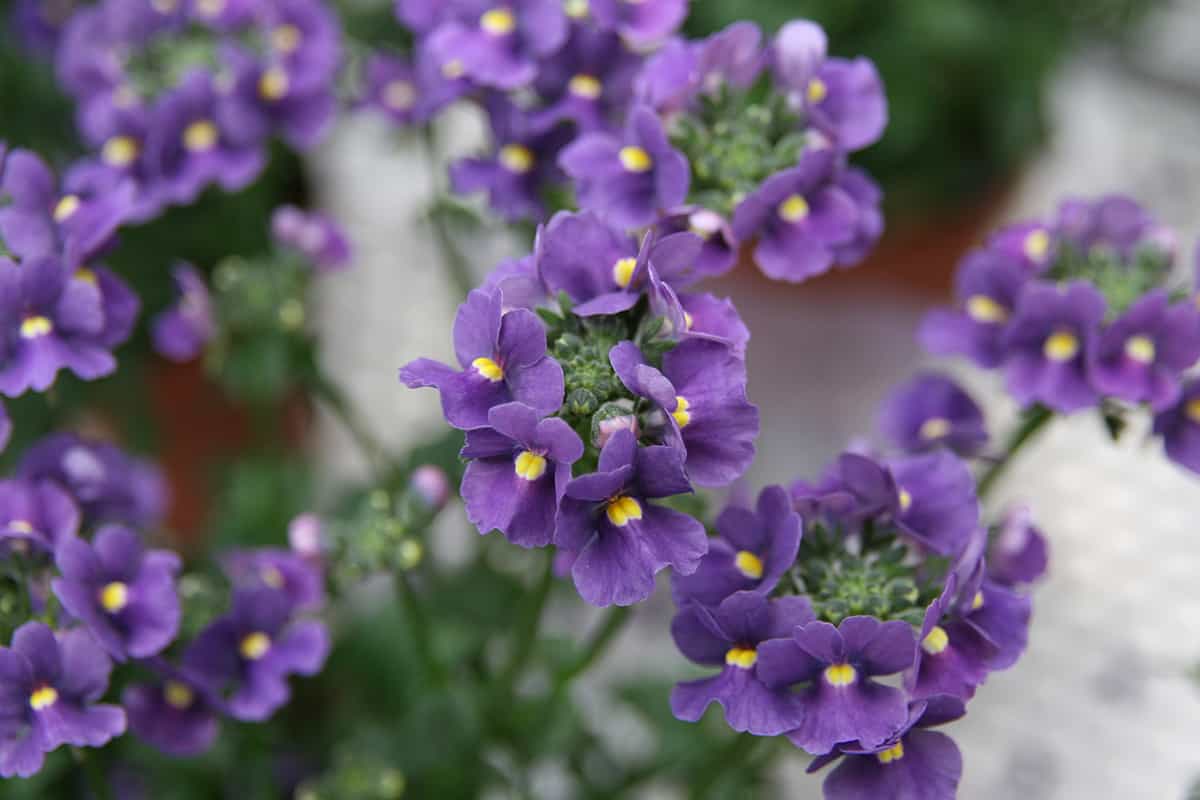
Nemesia flowers add vibrant color without the extra work of deadheading. These lively bloomers spruce up gardens with a tapestry of hues.
Native to South Africa, Nemesia thrives in cooler weather. Full sun encourages the brightest flowering, but they tolerate partial shade. With an ideal size ranging from 6 to 12 inches in height and width, Nemesia fits perfectly in small spaces or as a border plant. Your garden benefits from their compact and bushy growth habit, which lends itself to a neat appearance.
Dianthus
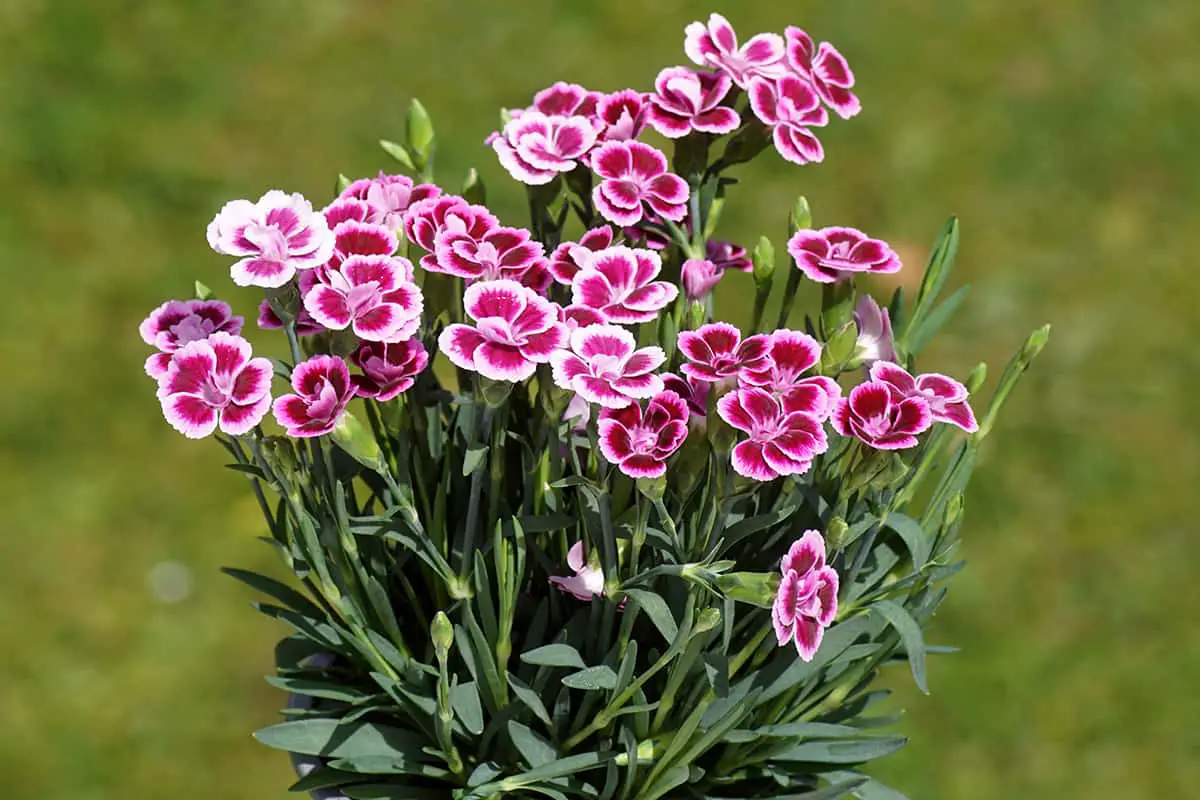
Dianthus plants, often called “pinks”, are known for their vibrant flowers. These plants thrive in full sun but can manage partial shade. They prefer well-drained soil and can resist dry spells to some extent. The dianthus flower makes an excellent choice for your garden as it blooms profusely without the need for deadheading. However, you might sometimes find benefits in pruning back dianthus to encourage a second flush of flowers.
The flowers come in shades of pink, red, and white. Although many varieties naturally shed their petals and continue to bloom, some still flourish after deadheading to tidy up the plant. Dianthus typically requires less maintenance than other flowering garden species. It’s a perfect addition if you’re seeking a low-effort yet attractive floral display.
For best growth, plant your dianthus in an area that receives at least six hours of sunlight each day. Water them when the soil feels dry to the touch, but be careful not to overwater.
Osteospermum (African Daisy)
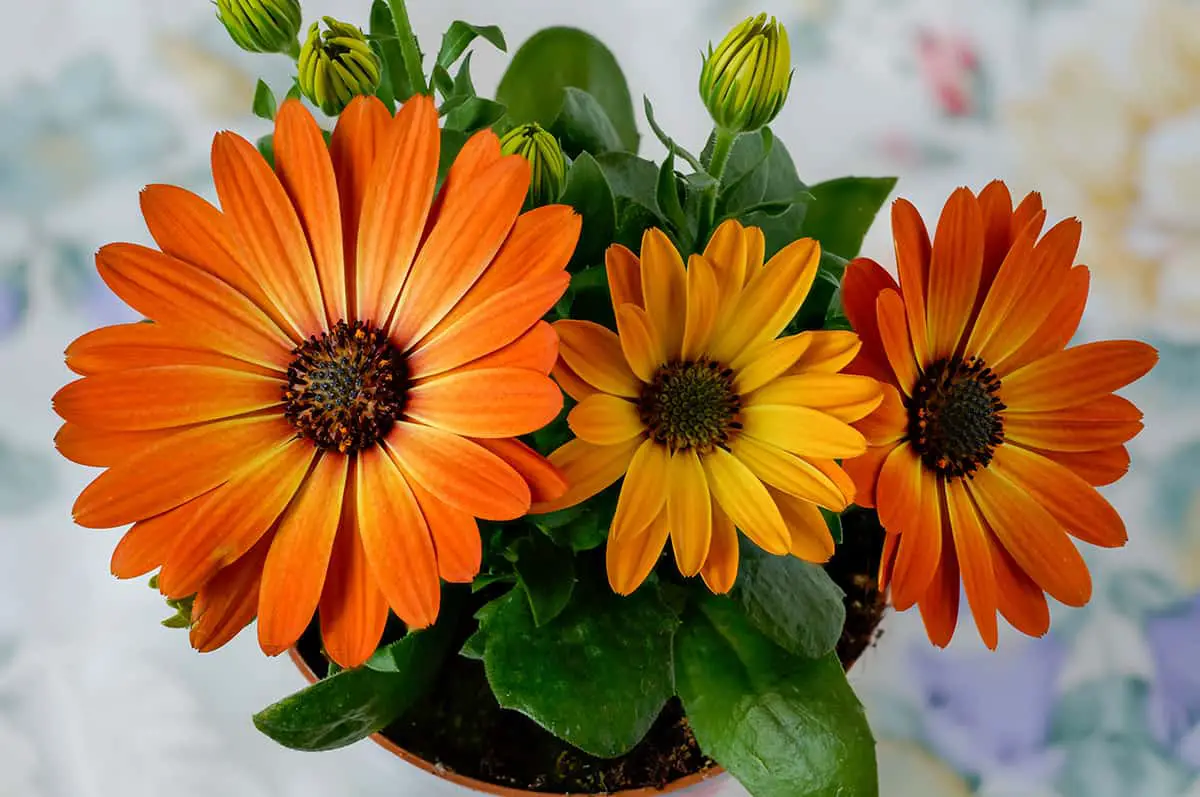
Osteospermum, or African Daisy, is a sun-loving plant that typically doesn’t require the removal of spent blooms to continue flowering. African daisies grow well in well-drained soil and full sun.
Your Osteospermum will attract attention with its substantial foliage and colorful blooms. The flowers feature a dark-blue center, often with a waxy look. You can find blooms in pink, purple, blue, or white. These plants are resilient and handle various conditions, though they prefer less humid climates.
To maintain your African Daisy, water it regularly during the growing season. Ensure it has good drainage to prevent root issues. Osteospermum does well in ground or in containers, offering flexibility for your garden design. These low-maintenance plants adapt well to coastal and arid regions.
Angelonia
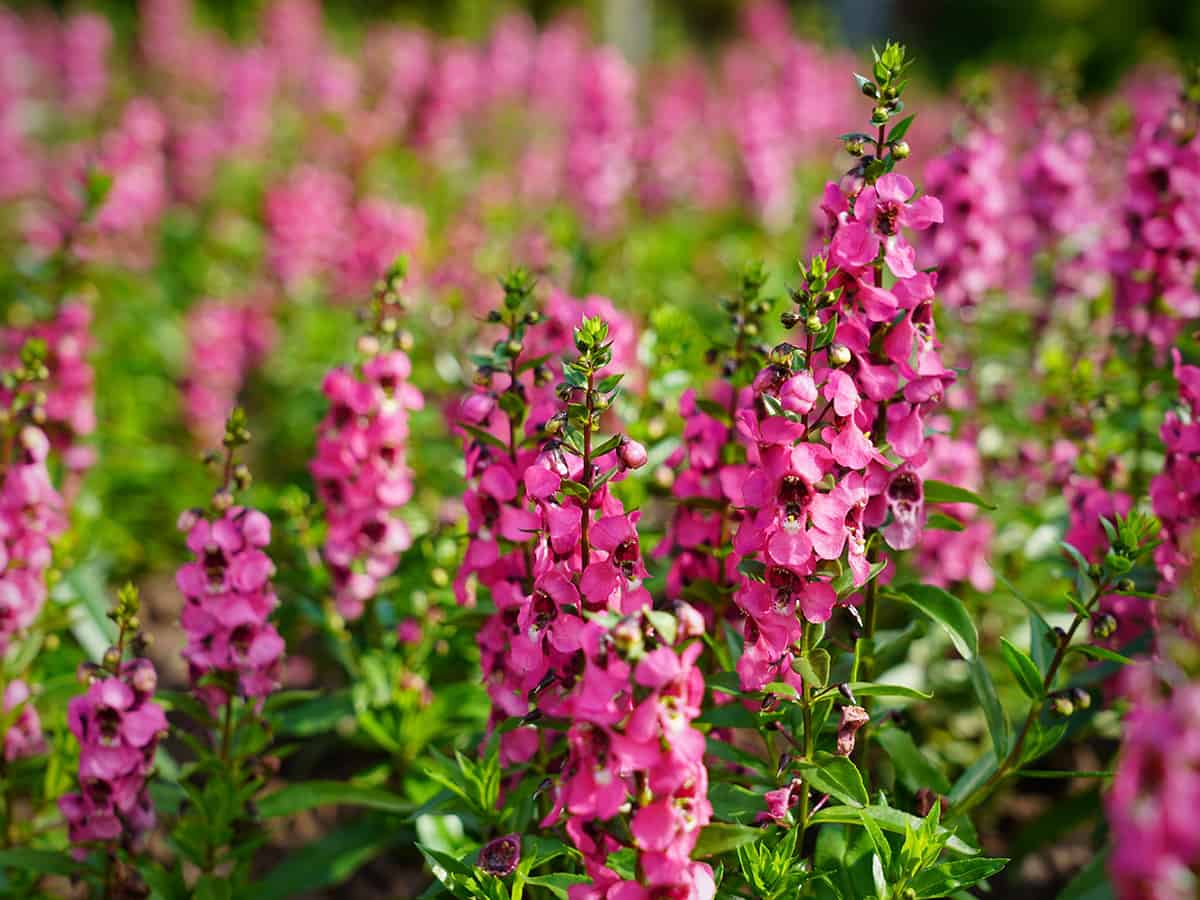
Angelonia, commonly known as the summer snapdragon, presents a vibrant and hassle-free choice for your garden.
Your Angelonia plants display a wealth of snapdragon-like flowers. They bloom continuously throughout the season. The variety of colors include white, pink, lavender, and purple. Angelonias are well-suited to both flower beds and containers.
With Angelonia, you also enjoy the benefit of sturdiness. These plants often resist the problems that plague other garden favorites. They are not typically required to be staked, standing strong even in tough conditions.
Lantana

Lantana plants offer you a vibrant garden without the extra work of deadheading. These tough and colorful plants flourish in hot weather. Lantana is recognized for its rounded clusters of small, brightly colored flowers. They range from yellow to red, attracting butterflies and hummingbirds to your space.
In suitable conditions, lantana acts as a perennial. In cooler climates, you will treat it as an annual. When the blooms fade, lantana naturally sheds the old flowers. This self-cleaning trait means that you don’t have to prune the old blooms to maintain its neat appearance. Some newer lantana varieties are even bred to limit seed production. This enhancement increases blooming without your intervention.
Portulaca
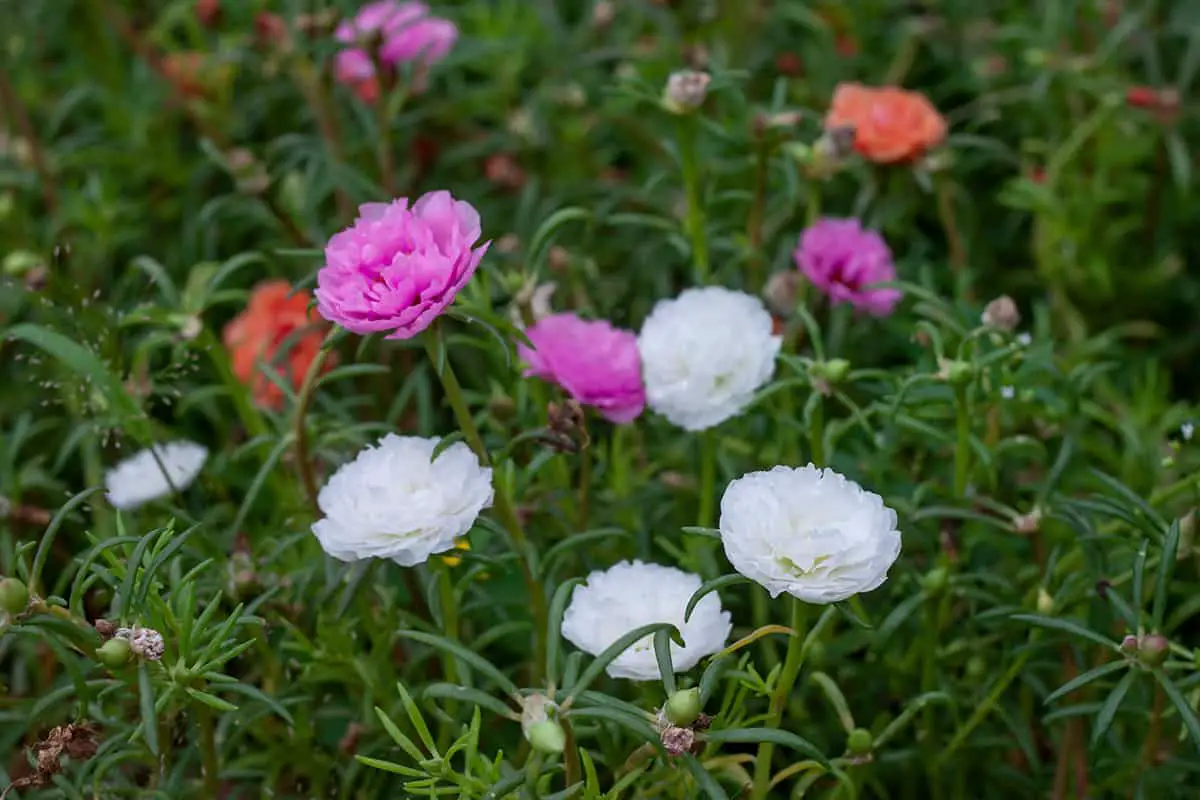
Portulaca is a drought-tolerant plant that thrives in hot, dry conditions. Its flowers fall off naturally, eliminating the need for deadheading.
Portulaca thrives in dry conditions. This plant, also called moss rose, provides vivid blooms. Its leaves store water, reducing the need for frequent watering. Portulaca flowers come in hues like red, orange, and yellow.
You’ll appreciate its maintenance ease. The blooms of portulaca naturally drop off after blooming.
Zinnia
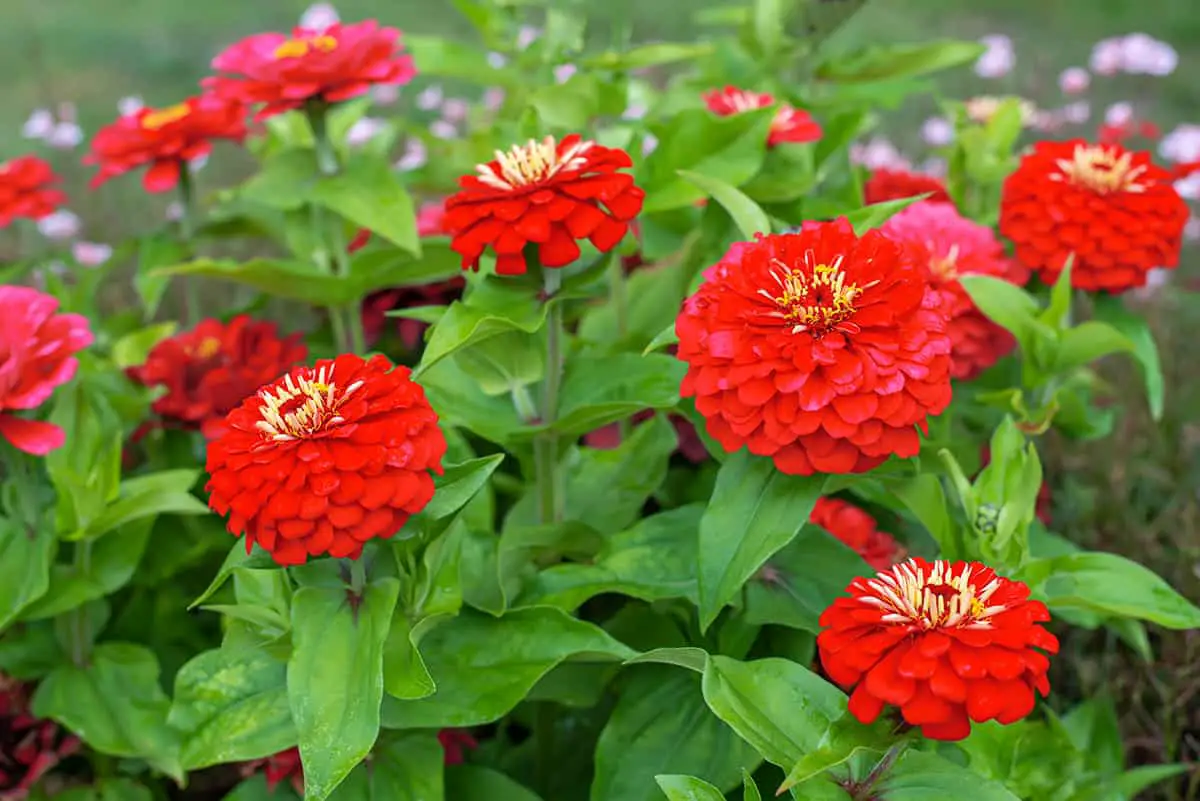
Zinnias are annuals known for their vivid flowers. They come in multiple colors and brighten any landscape. You can plant Zinnia elegans once, and enjoy a season full of blooms.
These flowers are robust and grow easily in warm climates. They need good air circulation and full sunlight to thrive. Your zinnias may attract butterflies, adding more life to your garden. Remember to water zinnias at the base to prevent fungal diseases.
Some zinnia varieties, like the Zahara zinnia, are especially low-maintenance. They fill the space with color and rarely require deadheading. These particular zinnias withstand harsh conditions and resist common diseases. It means you spend less time on upkeep and more on enjoyment.
Cosmos
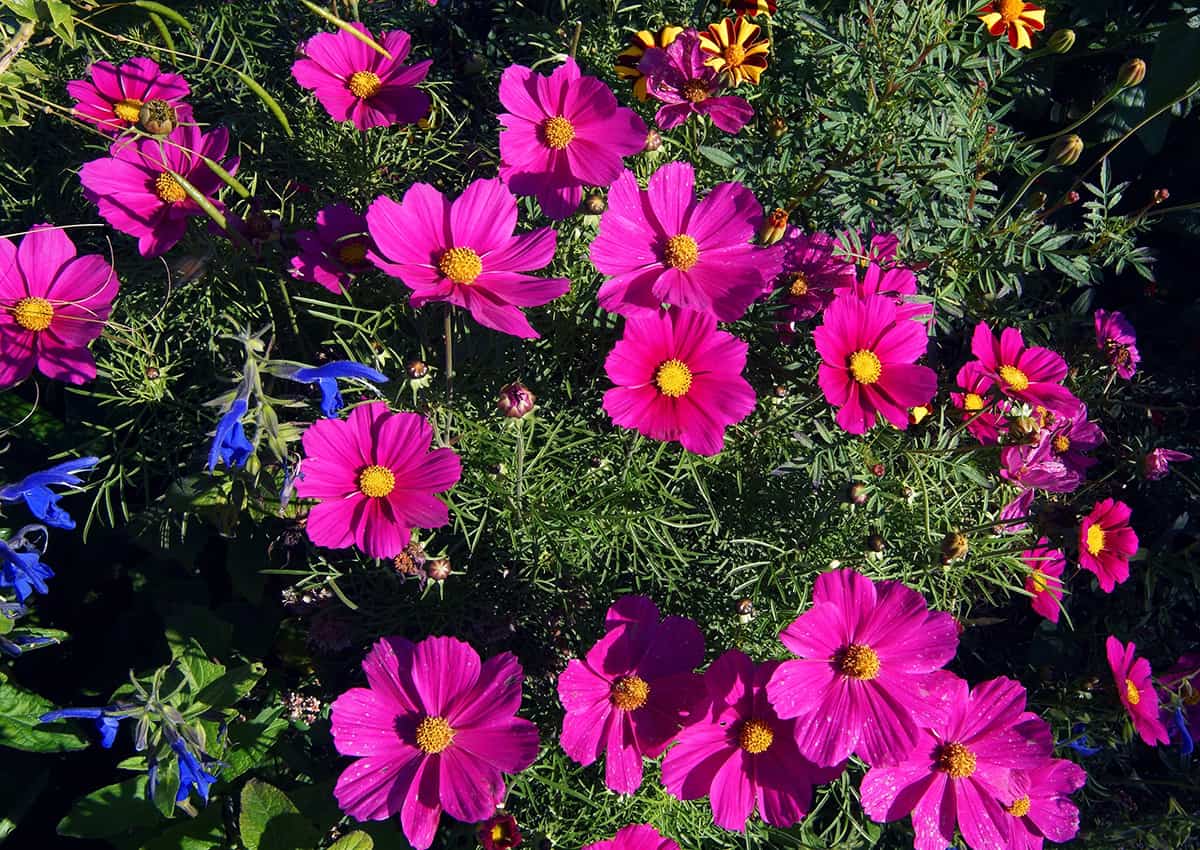
Cosmos grow well in poor soils, so they won’t require much attention from you. As they bloom from summer until frost, you can enjoy their vibrant colors for a long period. Cosmos plants come in varieties that need little care.
You can plant cosmos in areas with direct sunlight for part of the day. When you sow seeds, do so after frost is no longer a threat. If you need to stake them, it’s typically only for the taller varieties. This plant not only beautifies your garden but also attracts pollinators, aiding in the health of your garden’s ecosystem.
Watering cosmos demands simplicity. Provide them with about an inch of water weekly, keeping the soil just moist. Avoid over-fertilizing, as cosmos thrive with minimal fertilizer. In fact, too much can reduce blooming. Sometimes, you can trim plants to promote new growth, but deadheading is not necessary for continued blooming. Cosmos can self-seed, ensuring their return next year with little effort on your part.
Torenia
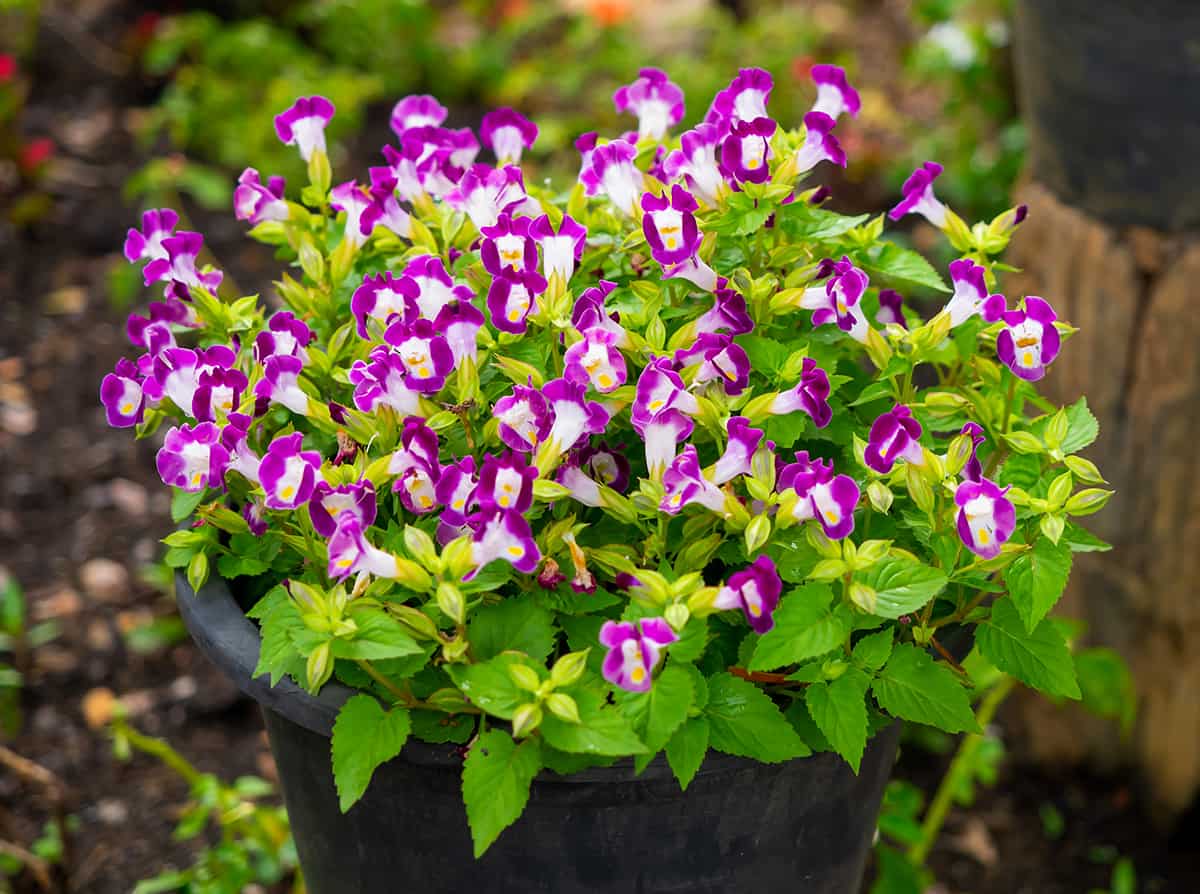
You’ll find Torenia flowers come in a vibrant array of colors including white, yellow, pink, violet, and purple. This variety allows you to mix and match, creating a tapestry of hues in your own garden.
This flower stands out with a unique center shape resembling a wishbone. You’ll enjoy the snapdragon-like blooms all season long. Torenia grows approximately 6 inches tall, with a trailing habit up to 30 inches. It’s perfect for the front of a border or spilling gracefully from containers.
In your shaded garden areas or even in sunnier spots, Torenia performs well without the need for deadheading. This means less maintenance for you. The flowers naturally drop off as they fade, encouraging new blooms. Your care includes regular watering to keep the soil moist and ensuring it’s planted in rich, well-draining soil.
Gaura
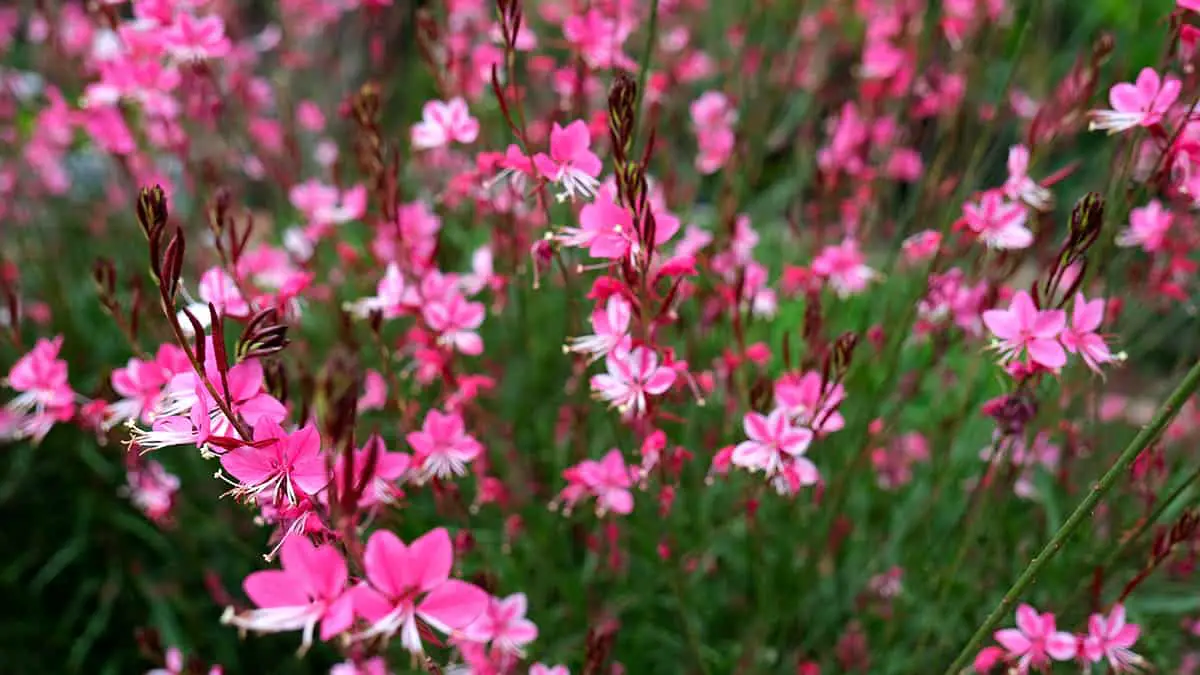
Gaura lindheimeri, commonly known as Whirling Butterflies, brings effortless elegance to your garden beds. This perennial does not require deadheading. It continuously blooms, featuring delicate flowers resembling butterflies.
The plant thrives in well-drained soil and enjoys full sun exposure. The foliage, a backdrop of green or sometimes reddish hues, enhances the white, pink, or striped flowers. This adaptable plant grows 3 to 5 feet tall and spreads 1 to 2 feet wide, filling your space with its airy presence.
Incorporate Gaura into your garden for its visual appeal and its carefree nature. Your Gaura’s flowers will bloom from spring to fall, drawing in pollinators like bees and butterflies. Despite the whimsical look, this plant is sturdy and tolerates various climates, including drought-like conditions once established.
